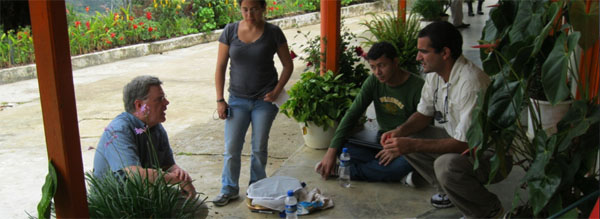Researchers look to deliver water (and energy) in ways both old and new
| Author: | William Meiners and Emil Venere |
|---|

Global delivery
Kimberly-Clark Corp. sponsored the fall 2010 GEP project, which turned the attention of Purdue engineers to the very real need for clean drinking water in remote parts of the world. The company operates paper production facilities in South America, including a plant near Barbosa, Colombia. Company officials wanted to improve water quality for area residents, many of whom are employees.
Untreated water from nearby streams is piped to elementary schools and homes in the villages of Las Peas, Buga and Graciano, which are accessible by narrow roads leading from Barbosa. The water contains particles and pathogens from sources such as dead leaves and cow manure.
Students on the Global Design Team determined that one of the most affordable and easy-to-maintain filtration methods for the communities is slow-sand filtration, which uses layers of sand and gravel to clean water. However, existing slow-sand filtering systems were too bulky and expensive for the communities, Jafvert says.
“We needed something lower cost for very rural areas where people are living with few resources,” he says.
Jafvert and the students created a new type of slow-sand filter contained in two five-gallon plastic buckets. Water is poured in the top bucket and emerges clear from the bottom bucket but still requires boiling before drinking.
“We created a design that’s simple, portable and easy to clean,” says Jafvert of the elegant solution he describes as “low-tech.”
The team of Purdue students installed the new drinking water filtration systems at three elementary schools, one in each of the communities. About 20 children attend each school.
The project began last fall with a course developed through the Global Engineering Program and will be offered again by the GEP in cooperation with the College of Engineering’s Division of Environmental and Ecological Engineering. Nine students in the class came from a range of disciplines, including civil engineering and agricultural and biological engineering.
“The project made me feel like I was contributing to a greater good because what we designed went into schools and communities where there is a serious water shortage problem,” says Craig B. Collins, a civil engineering senior. “We were able to not only do the research but also build the filters. The team had talented students from different majors and different cultures. I feel I want to work on similar projects in the future to help improve the quality of life for people in developing regions.”
The systems, which are capable of filtering 20 liters per day, cost about $43.
“We could probably bring that down even further, to $25 or $30,” Jafvert says. “You pour 20 liters in and you collect 20 liters, and you do the same thing the next day. The sand must be the right size. It’s not so fine that the flow rate is inhibited, and it provides a huge surface area for bacteria to attach to.”
The system behaves like a miniature aquifer because it slowly cleans the water.
“The water flow is slow enough that bacteria attached to sand grains can metabolize organic contaminants,” Jafvert says. “You have good and bad bacteria. The good bacteria help to remove the dissolved organic contaminants. Pathogens in manure or human waste are removed by attachment to the large surface area of the sand.”
Students worked on the project in a one-semester, three-credit course, but the project will continue in the fall semester with new students. Next semester civil engineering professor Loring Nies will join the GEP Colombia team. He and Jafvert may pursue improvements, including the replacement of the bottom gravel layers.
“It would be much easier if we had a porous plate on the bottom,” Jafvert says. “Otherwise, you spend lot of time sieving material to create the layers.”
Even though the filters clean the water, it still has to be boiled to kill remaining bacteria. However, Jafvert envisions future designs that use filtration cartridges or chlorine bleach to remove bacteria instead of boiling. He also is looking into future designs for a larger system capable of providing clear water for a whole community.
The Global Engineering Program was critical in creating the project and has similar design teams working on projects in Cameroon, Kenya, Jordan, Lebanon and Palestine.
